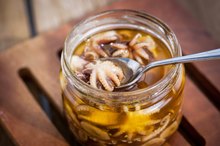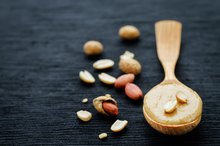What does fact checked mean?
At Healthfully, we strive to deliver objective content that is accurate and up-to-date. Our team periodically reviews articles in order to ensure content quality. The sources cited below consist of evidence from peer-reviewed journals, prominent medical organizations, academic associations, and government data.
- Harvard School of Public Health: Omega-3 Fatty Acids: An Essential Combination
- Clinics in Dermatology: Healing Fats of the Skin: The Structural and Immunologic Roles of the Omega-6 and Omega-3 Fatty Acids
- Clinics in Dermatology: Healing Fats of the Skin: The Structural and Immunologic Roles of the Omega-6 and Omega-3 Fatty Acids
The information contained on this site is for informational purposes only, and should not be used as a substitute for the advice of a professional health care provider. Please check with the appropriate physician regarding health questions and concerns. Although we strive to deliver accurate and up-to-date information, no guarantee to that effect is made.
Does Sole Contain Omega-3 Fats?
Most of the omega-3 fatty acids your body needs to stay healthy must come through your diet. Fish are the major sources of two of the essential omega-3 fatty acids 3. Even though sole is not usually found at the top of the list, it turns out to be a good source, according to the U.S. Department of Agriculture. It’s also packed with protein, vitamin B-12 and vitamin D.
Sorting Out the Omega-3s
One of the three main omega-3 fatty acids -- alpha-linolenic acid, or ALA -- comes from plants, such as walnuts, flaxseeds and vegetable oils. The other two omega-3s are found together in fish and fish oil. The two omega-3 fatty acids in fish oil are sometimes reported separately, so you may also encounter their names: eicosapentaenoic acid, or EPA, and docosahexaenoic acid, or DHA. EPA and DHA are the most potent omega-3 fatty acids, according to Colorado State University Extension.
- One of the three main omega-3 fatty acids -- alpha-linolenic acid, or ALA -- comes from plants, such as walnuts, flaxseeds and vegetable oils.
- The two omega-3 fatty acids in fish oil are sometimes reported separately, so you may also encounter their names: eicosapentaenoic acid, or EPA, and docosahexaenoic acid, or DHA.
Benefits of Fish Oil
List of Foods With Essential Fatty Acids
Learn More
EPA and DHA help reduce inflammation throughout your body. They affect the function of cell membranes, and they help form the barrier in your skin that prevents dehydration. During pregnancy, DHA is essential for the normal development of the baby’s brain and eyes. EPA and DHA lower your risk of cardiovascular disease by reducing levels of triglycerides and cholesterol, lowering your blood pressure and preventing arrhythmias, or irregular heartbeats, according to the Harvard School of Public Health. If you already have heart disease, getting enough fish oil may lower your risk of dying from a heart attack.
- EPA and DHA help reduce inflammation throughout your body.
- EPA and DHA lower your risk of cardiovascular disease by reducing levels of triglycerides and cholesterol, lowering your blood pressure and preventing arrhythmias, or irregular heartbeats, according to the Harvard School of Public Health.
Amount in Sole
Even though sole is low in fat, with just 2 grams in a 3-ounce serving, it's a good source of EPA and DHA. You'll get 0.14 grams of EPA and 0.11 grams of DHA in 3 ounces of sole, according to the U.S. Department of Agriculture. Their combined total of 0.26 grams provides 23 percent of women's and 16 percent of men's recommended daily intake. Along with the omega-3s, one serving of sole only has 73 calories yet supplies 13 grams of protein, 20 percent of your RDA of vitamin D and 41 percent of your RDA for vitamin B-12.
- Even though sole is low in fat, with just 2 grams in a 3-ounce serving, it's a good source of EPA and DHA.
- Along with the omega-3s, one serving of sole only has 73 calories yet supplies 13 grams of protein, 20 percent of your RDA of vitamin D and 41 percent of your RDA for vitamin B-12.
Recommended Intake
Rockfish Nutrition Facts
Learn More
Your body converts some of the ALA you consume into EPA and DHA, but it doesn’t produce enough, so the amount you get in your diet is important, according to a report in the June 2011 issue of “Circulation.” The recommended daily intake for total omega-3 fatty acids is 1.1 grams for women and 1.6 grams for men. The Institute of Medicine has not established separate recommendations for EPA and DHA, but some organizations offer guidelines. Ohio State University suggests getting 250 to 500 milligrams of combined EPA and DHA daily. If you have cardiovascular disease, the American Heart Association recommends consuming 1 gram of combined EPA and DHA daily.
- Your body converts some of the ALA you consume into EPA and DHA, but it doesn’t produce enough, so the amount you get in your diet is important, according to a report in the June 2011 issue of “Circulation.” Ohio State University suggests getting 250 to 500 milligrams of combined EPA and DHA daily.
Related Articles
References
- USDA Nutrient Database: Fish, Flatfish (Flounder and Sole Species), Cooked, Dry Heat
- Harvard School of Public Health: Omega-3 Fatty Acids: An Essential Combination
- Circulation: Recent Advances in Preventive Cardiology and Lifestyle Medicine: Components of a Cardioprotective Diet
- Circulation: American Heart Association Scientific Statement: Diet and Lifestyle Recommendations Revision 2006: Other Dietary Factors That Affect CVD Risk
- Ohio State University: Everything You Need to Know About Fish Oil Supplements
- Clinics in Dermatology: Healing Fats of the Skin: The Structural and Immunologic Roles of the Omega-6 and Omega-3 Fatty Acids
- Jouris, K. B., McDaniel, J. L., & Weiss, E. P. (2011). The effect of omega-3 fatty acid supplementation on the inflammatory response to eccentric strength exercise. Journal of Sports Science & Medicine, 10(3), 432.
- Tartibian, B., Maleki, B. H., & Abbasi, A. (2009). The effects of ingestion of omega-3 fatty acids on perceived pain and external symptoms of delayed onset muscle soreness in untrained men. Clinical Journal of Sport Medicine, 19(2), 115-119.
- Parra, D., Ramel, A., Bandarra, N., Kiely, M., MartÃnez, J. A., & Thorsdottir, I. (2008). A diet rich in long chain omega-3 fatty acids modulates satiety in overweight and obese volunteers during weight loss. Appetite, 51(3), 676-680.
- Omega-3 Fatty Acids. (2016). Retrieved January 18, 2018, from http://ods.od.nih.gov/factsheets/Omega3FattyAcidsandHealth-HealthProfessional/
- Daley, C. A., Abbott, A., Doyle, P. S., Nader, G. A., & Larson, S. (2010). A review of fatty acid profiles and antioxidant content in grass-fed and grain-fed beef. Nutrition Journal, 9(1), 10.
- Covington, M. B. (2004). Omega-3 fatty acids. Atlantic, 1(2.0)
Writer Bio
Sandi Busch received a Bachelor of Arts in psychology, then pursued training in nursing and nutrition. She taught families to plan and prepare special diets, worked as a therapeutic support specialist, and now writes about her favorite topics – nutrition, food, families and parenting – for hospitals and trade magazines.









